
Worlds within Worlds: Imperial Paintings from India and Iran
Feb 04, 2012 Exhibition
Image above: Sad'i and the Youth of Kashgar / Ascribed to Bihzad, From a copy of the Gulistan (Rosegarden) by Sa'di, Iran, present-day Afghanistan, Herat, 1486, Opaque watercolor, ink, and gold on paper / Lent by the Art and History Trust, LTS 1995.2.33 / Image: Courtesy of Freer Gallery of Art and Arthur M. Sackler Gallery
India’s Mughal emperors, who reigned over a vast and wealthy empire that extended over most of the South Asian subcontinent between the 16th and 19th centuries, were passionate about lavish manuscripts and paintings. Between 1556 and 1657, the greatest Mughal patrons —the emperors Akbar, Jahangir and Shah Jahan— formed grand workshops that brought together and nurtured India’s leading painters, calligraphers and illuminators.
The exhibition’s title, 'Worlds within Worlds', refers to the complex layering of multiple images within single folios, their many references to Persian and European styles and subjects and the emperors’ sense of self as world rulers.
For the Mughal emperors, the arts of the book embodied refinement and imperial identity. Sophisticated connoisseurs, they took a personal interest in their artists and their individual styles. In a constant play of tradition and innovation, court painters, calligraphers and illuminators built upon a Persian cultural heritage, cited European motifs and keenly captured the observed world to create a distinctively Mughal ethos.
The exhibition will open with a selection of the Persian book arts that the Mughal emperors collected, revered and encouraged their artists to rival and surpass. Among them is an intricately detailed school scene painted in 1486 for a Timurid ruler in the fabled garden city of Herat, in present-day Afghanistan. It has been ascribed to the artist Bihzad—against whom all other Persian and Mughal artists were measured.
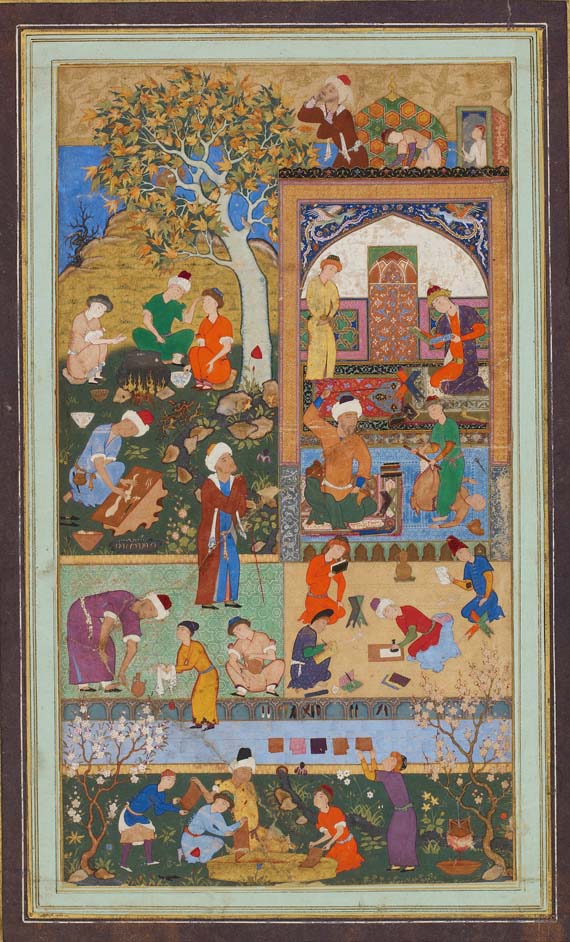 A School Scene / By Mir Sayyid Ali, Iran, Tabriz, ca. 1540, Opaque watercolor, and gold on paper / Purchase, Smithsonian Unrestricted Trust Funds, Smithsonian Collections Acquisition Program, and Dr. Arthur M. Sackler, Arthur M. Sackler Gallery, S1986.221 / Image: Courtesy of Freer Gallery of Art and Arthur M. Sackler Gallery
A School Scene / By Mir Sayyid Ali, Iran, Tabriz, ca. 1540, Opaque watercolor, and gold on paper / Purchase, Smithsonian Unrestricted Trust Funds, Smithsonian Collections Acquisition Program, and Dr. Arthur M. Sackler, Arthur M. Sackler Gallery, S1986.221 / Image: Courtesy of Freer Gallery of Art and Arthur M. Sackler Gallery
The second section will focus on the groundbreaking synthesis achieved by Persian emigres and local Indian artists under the emperor Akbar (ruled 1556-1605). The personal dynamism of Akbar and the Mughal fascination for capturing the appearances of people and places shine throughout these foundational works of the Mughal school. Highlights include three dreamlike works by the renowned Farrukh Beg that demonstrate how artists with distinctive styles contributed to the broader imperial image.
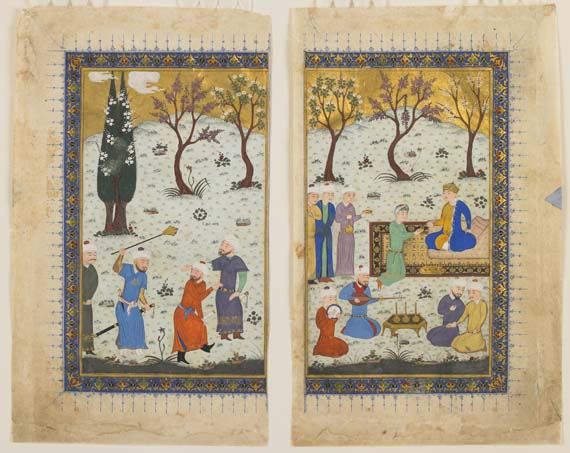 A Prince Enthroned / Iran, present-day Afghanistan, Herat, ca. 1425-30, Opaque watercolor, and gold on paper / Purchase, Smithsonian Unrestricted Trust Funds, Smithsonian Collections Acquisition Program, and Dr. Arthur M. Sackler, Arthur M. Sackler Gallery, S1986.141-2 / Image: Courtesy of Freer Gallery of Art and Arthur M. Sackler Gallery
A Prince Enthroned / Iran, present-day Afghanistan, Herat, ca. 1425-30, Opaque watercolor, and gold on paper / Purchase, Smithsonian Unrestricted Trust Funds, Smithsonian Collections Acquisition Program, and Dr. Arthur M. Sackler, Arthur M. Sackler Gallery, S1986.141-2 / Image: Courtesy of Freer Gallery of Art and Arthur M. Sackler Gallery
The final two groups of works were created under Akbar’s son and grandson, whose names, Jahangir (Seizer of the World) and Shah Jahan (King of the World), reveal the dynasty’s growing sense of imperial power within the world. The emperor Jahangir ruled from 1605-27 when the Mughal empire was stable, vast, incredibly wealthy and globally connected. His artists brought the Mughal aesthetic to its peak of technical refinement, as illustrated in the Gulshan album folios and lacquer book cover that are a highlight of the exhibition. These exquisitely realized works freely appropriate motifs and styles from diverse sources into richly layered tapestries of image and meaning.
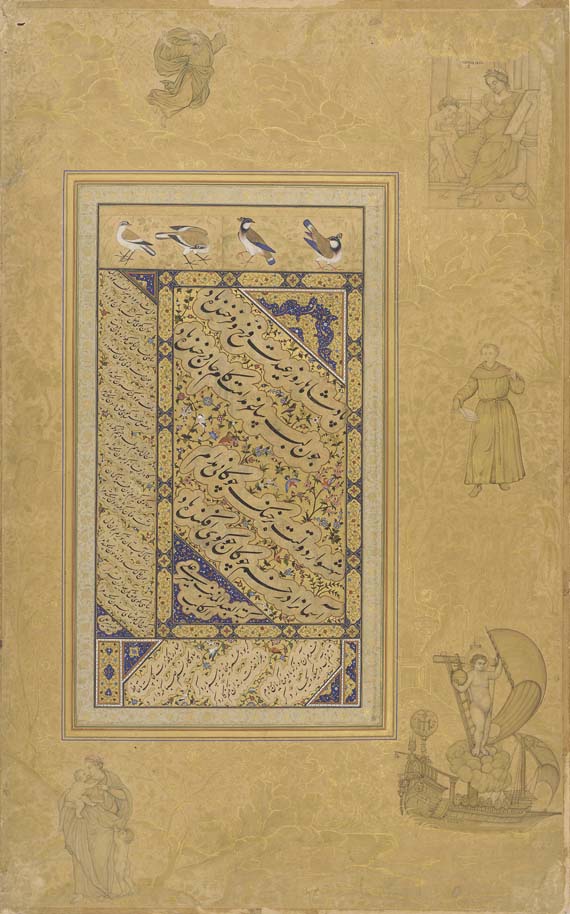 Folio from the Gulshan Album / Calligraphy by Mir Ali al-Katib, Bokhara, ca. 1540; Borders, India, Mughal dynasty, ca. 1600, Opaque watercolor and gold on paper / Purchase, Freer Gallery of Art, F1956.12 / Image: Courtesy of Freer Gallery of Art and Arthur M. Sackler Gallery
Folio from the Gulshan Album / Calligraphy by Mir Ali al-Katib, Bokhara, ca. 1540; Borders, India, Mughal dynasty, ca. 1600, Opaque watercolor and gold on paper / Purchase, Freer Gallery of Art, F1956.12 / Image: Courtesy of Freer Gallery of Art and Arthur M. Sackler Gallery
 Emperor Jahangir embracing Shah ‘Abbas of Persia from the Saint Petersburg Album / By Abu’l Hasan, India, Mughal dynasty, ca. 1618, Opaque watercolor, gold and ink on paper / Purchase, Freer Gallery of Art, F1945.9a / Image: Courtesy of Freer Gallery of Art and Arthur M. Sackler Gallery
Emperor Jahangir embracing Shah ‘Abbas of Persia from the Saint Petersburg Album / By Abu’l Hasan, India, Mughal dynasty, ca. 1618, Opaque watercolor, gold and ink on paper / Purchase, Freer Gallery of Art, F1945.9a / Image: Courtesy of Freer Gallery of Art and Arthur M. Sackler Gallery
The exhibition will conclude with a selection of superb folios produced for the albums of Jahangir’s son, the emperor Shah Jahan (1627-57). Like the palaces and Taj Mahal that he built, these are extraordinary works of perfection. Highlights include six folios from the Late Shah Jahan Album, which have sumptuous borders that exemplify the emperor’s love of jewels, flowers and grandeur.
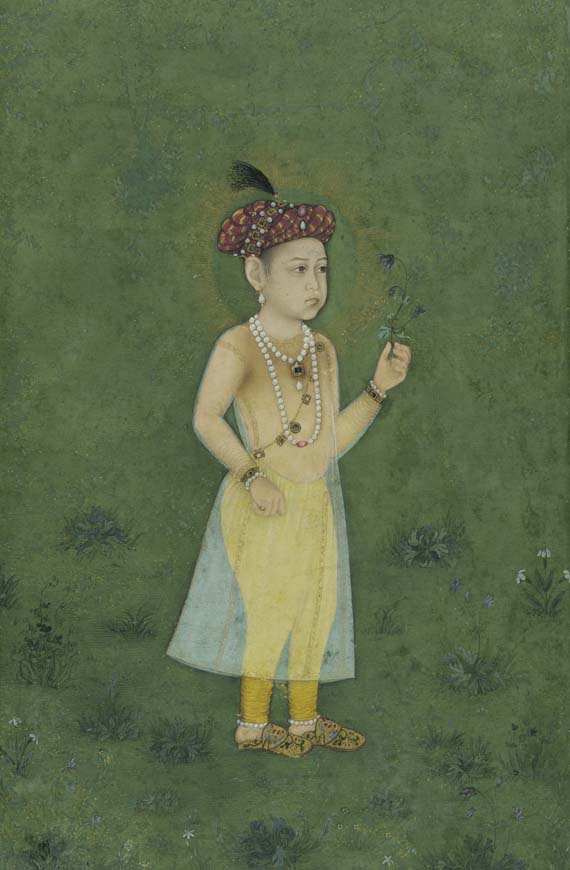 Prince Shah Shuja from the Late Shah Jahan Album / India, Mughal Dynasty, 1650, Opaque watercolor, ink and gold on paper / Lent by the Art and History Collection, LTS 1995.2.98 / Image: Courtesy of Freer Gallery of Art and Arthur M. Sackler Gallery
Prince Shah Shuja from the Late Shah Jahan Album / India, Mughal Dynasty, 1650, Opaque watercolor, ink and gold on paper / Lent by the Art and History Collection, LTS 1995.2.98 / Image: Courtesy of Freer Gallery of Art and Arthur M. Sackler Gallery
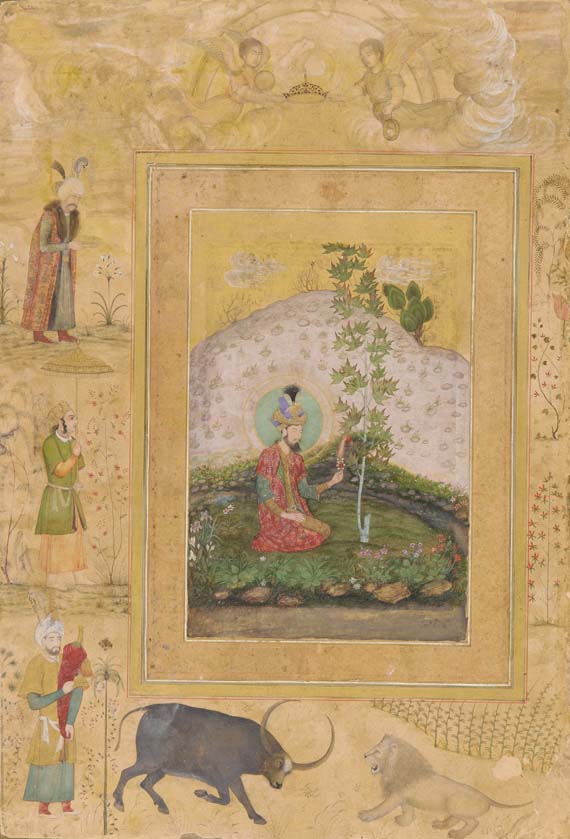 Humayun Seated in a Landscape from the Late Shah Jahan Album / By Payag, India, Mughal dynasty, ca. 1650, Opaque watercolor and gold on paper / Purchase, Smithsonian Unrestricted Trust Funds, Smithsonian Collections Acquisition Program and Dr. Arthur M. Sackler, Arthur M. Sackler Gallery, S1986.400 / Image: Courtesy of Freer Gallery of Art and Arthur M. Sackler Gallery
Humayun Seated in a Landscape from the Late Shah Jahan Album / By Payag, India, Mughal dynasty, ca. 1650, Opaque watercolor and gold on paper / Purchase, Smithsonian Unrestricted Trust Funds, Smithsonian Collections Acquisition Program and Dr. Arthur M. Sackler, Arthur M. Sackler Gallery, S1986.400 / Image: Courtesy of Freer Gallery of Art and Arthur M. Sackler Gallery
In honor of the Sackler’s 25th anniversary year, 'Worlds within Worlds' will be accompanied by another Sackler milestone: the publication of the revised and expanded Imperial Image, written by the pre-eminent Mughal painting historian and former director of the Sackler, Milo Beach. The revised Imperial Image expands on the original, published in 1981, by including the great Mughal paintings in the Sackler Gallery and Freer acquisitions over the past three decades.
Comments
Add a comment